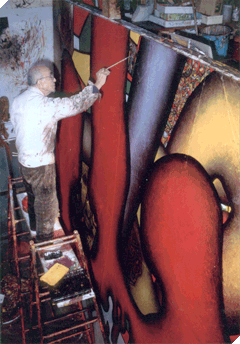1939 - 1947 This period is documented in his short autobiography. 1947 - 1979 Works as an artist and teacher. 1944 - Exhibits his artwork in various exhibitions. 1953 - 2000 Organizes a wide range exhibitions with work of others. 1987 Stops teaching and devotes his work solely to art. 2003 - Personal exhibition in Fukushima prefecture museum 2003 Dies at the age of 84. |
|||
His positive energy might have helped getting through the hard times, not only during his illness, but during the war as well. He hardly talked about the difficulties he had to face and how he was able to return to his family in Japan after the war. I imagine being in exile must have been a difficult situation for him. I met him in 1983. It was fantastic to get to know him, he taught me a lot about art; his concentration and dedication towards his art has been incredible. He produced an incredibly large number of paintings, drawings and objects full of black humor. I always felt a great respect for Hashimoto as a person and as an artist. |
|||
September, 2002 I started my army life in 1939, in the Mie prefecture in Japan. Two weeks after I enrolled into military service, I joined the occupation forces in Lisui, China, close to the city of Nanking. We fought against the Chinese Army and I was assigned to stand guard. After three months in the service, I became very sick and was sent to an Army hospital. My condition improved in the hospital and I asked the nurse to get me some pencils, papers and watercolor paint. I started to make paintings of the landscape surrounding the hospital. Later, Kesao a friend was luckily able to get me some oil paint. The painting of landscape seen from the hospital roof still exists. I was transferred to the Hiroshima Army Hospital and became quite active making drawings of my colleagues, sick soldiers, etc. (Part of these drawings still exist) When I was transferred once more to another army hospital, the free atmosphere to create things ceased to exist. I wasn't able to continue making drawings and when I completely recovered I joined the Tsu army unit. I returned to army life, which meant doing military exercise and physical training everyday, there was no time to paint. Every now and then I hid myself under the bed to avoid training. One day, my officer selected some soldiers to go to the front in China, but I was not on the list. It seemed more interesting to go to the front than staying in Japan where I would be doing heavy physical exercise on a daily basis. I knew being there would be dramatic but it would also be adventurous and liberating; then I could at least paint more. So I applied and soon after I left. My officer probably thought I did it because of patriotism. In December, we were given summer clothes and sailed from Nagoya Port into the Pacific Ocean. We were not told what our destination was. In the ship I made drawings of soldiers lying and relaxing on the floor. One of the drawings is printed in my catalogue 'Shooting the times.' which Fukushima museum published in 2003.  In a transportation ship, 1941 On the ship we heard the big news of Japanese troops attacking Pearl Harbour. It turned out that our troops were ordered to attack the Philippines. We landed close to Davao at the Mindanao Islands, which is the southern part of the Philippines. The defending troops fled into the jungle as our troops held the newly conquered ground in the occupied area. I started to make drawings. 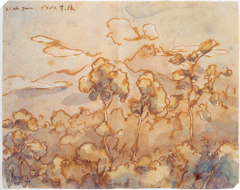 Mindnao Islands, 1942 We were winning and subsequently we had more time to rest. The drawing "At the front in Digos" which I made there still exists. After a while Japanese troops made a sweeping attack and the enemy surrendered in the jungle. We were near Dabao after two months of the general attack when a Philippine boy his nickname was Saburou, asked me to paint a fighting scene. I drew the fighting soldiers with crayon on veneer board and gave it to Saburou as a present. That was the only drawing of a war scene I have ever made. I don't think it still exists but I do wonder if Saburou survived the war and what kind of life he has lived afterwards. Our unit moved from Mindanao Island to Ruson Island near Manila and we started to implement public peace and order, against the guerrilla fighting for example. I was given an administrative job and was able to continue making drawings. I started to work as a teacher in a Japanese primary school and got involved with a propaganda group. We organized dance parties for the Japanese soldiers and I continued making lots of new work. 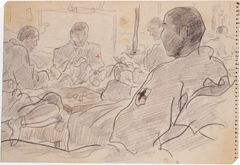 A drawing in a war period, 1941 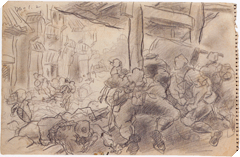 A drawing in a war period, 1941 |
|||
|
Japan was loosing the war and in 1944. I was discharged from military service and went back to Japan. In the same year I returned with my wife to the South Manchurian Railway Company to earn money in the city of Dalian, China. The Dalian City Centre Gallery organized an exhibition with drawings I made during the war. After the exhibition I was asked to join the Art & Advertising Department of the company. I started to make the company's ads and designed their public relation activities. The head of the company treated me as an artist and asked to make some trips to the ancient surroundings of Manchuria . I was assigned to make drawings of my trips. During the war Japanese art exhibitions were limited and obliged to show work that encouraged the fighting spirit. There were three such exhibitions. One of them, 'the Decisive Battle Art Exhibition', was held in the Mitsukoshi Department Store in Dalian City. This was just one year before the end of the war. The artists in the show were mainly war artists and some local artists. I was selected as a local artist. I could not get hold of any oil paint so I drew with crayon on a paper. The drawing depicted a group of tired looking soldiers with their equipment, impassively standing at the docks. I decided to name the drawing Tenshin. (The word refers to a shift in one's position, when one is transferred from one place to another but it can also be used in military terms) It turned out to be a risky decision: I wasn't aware of the fact that the government controlled newspaper referred to the actual retreat of the army since Japan was in fact loosing the war; they tried to hide the information and intended to keep the moral high among the civilians as long as possible. I did not know Japan was loosing the war, I wanted to portray the reality of the soldiers who were experiencing the situation. As a matter of fact I never worked with predetermined compositions, I have always been more interested in being directed by the course of events and discover where each journey takes me. As the exhibition went underway, two important incidents happened in my life. During the opening I was sitting on the lowest seat. There was a strong hierarchy, even between artists. The war artists' representative came to me and said, "Are you Mr. Hashimoto? Your painting is very real." Later I recognised him, the late Mr Mukai Junkichi, a very well known Japanese artist. I was not satisfied by the exhibition. Most of the paintings depicted fighting soldiers looking as if they were playing sports. Very unreal. The paintings of the local artists were more or less self-explanatory because they tried to encourage a war sentiment and a sense of patriotism; generally the level was low. By comparison my painting seemed more realistic than the others. It was true what the representative said and the situation to just look at art and admire paintings was very difficult the standing soldiers echoed this. The exhibition was organized as propaganda to encourage a fighting spirit but his remark "your painting is a real painting", has supported my life as an artist. It made me realize that the purpose of painting is not to express something general, but to make something based on personal values and experiences, reflecting my own perspective on reality. A few days later, I was ordered to report myself at the Kenpeitai (Military Police in Japanese), the highest authority in Japan at that time. When I appeared at the Police station, they shouted at me, "You are against the war, aren't you! There is nothing of a fighting spirit in your painting at all! " I thought I was going to be killed. They felt I suggested a new meaning to the word Tenshin, suggesting we would loose the war. I apologized and explained that I myself had recently fought at the front. I ran away and luckily they didn't follow me. It was such a relief! (Interestingly, the contemporary Japanese dictionary now refers to the word Tenshin as a euphemism, i.e. the retreat of an army.) A few months later I was called up into the army and joined the unit stationed at Liaoyang in Manchuria. two months later the War ended, our weapons were taken. It became a horrible situation and we heard many frightening stories. We heard Russian troops were coming to take us as war prisoners to transport us to Siberia. We organized an escape by train fortunately one of my colleagues from the railway company was able to drive the train. Many people joined the trip, even though it was very risky to go through the different Chinese areas. Normally it would take half a day, but we had to change rails after every section and after one day we arrived in Dairen. I managed to return to my house in Dalian. Obviously I was very pleased to see my wife and first son. We started to live a life under detention. The best way to survive was to sell the furniture but we had nothing to sell. We did everything to earn money; cleaning, selling ice on the street, etc. The best way to make a living for people like me was to draw portraits of the Chinese. I went to China town to work even though it was dangerous. My friends and I also designed café interiors. The Chinese asked us to paint dragons in black ink and the Russians only asked for portraits of Stalin. It lasted a year and a half before we were able to return to Japan and when the moment finally came I had to make a big decision about my works. The people going back to Japan where restricted in what they were able to carry with them. I had to throw away many of my drawings and paintings. I hid a few drawings and landscape paintings of Manchuria between the Futon we carried with us. When I bid farewell to Mr Muda Takaji, the chief of the Art Section at the Manchurian Railway Company, he said to me "You will make fantastic paintings in future." "When you leave this fully packed train, you will jump with joy." Implying I won' t loose my cheerfulness and sense of humour regardless of the situation I'm in. That I would carry on working and creating... It seems I have been searching to find the real nature of human beings, but it has been hard to understand what this consists of. According to the critics Sakazaki Otsuro and Hariu Ichirou, my work seems to be evolving around humour. That is to say I see the human being as a humorous creature, culture as a humorous product, and the towns we live in as part of a humorous landscape. This corresponded with what Muda Takaji said. But of course I only started to recognize it recently. |
Manchu The Manchu were originally nomads from Manchuria, northeast of China. They conquered China in 1644, but kept themselves largely separated from the Chinese. In 1931 the Japanese army invaded Manchuria. The Japanese set up a new country in Manchuria called Manchukoku. They made P'u Yi the chief executive, who wanted to be emperor. The Chinese government called Manchukoku a fake country and P'u Yi a traitor to China. The only major countries to recognize Manchukoku's existence were Japan, Italy and Germany. During World War II Japan developed Manchukoku as a military-industrial base. At the end of the war Soviet forces invaded Manchuria. Manchuria was eventually returned to Chinese control. |
||
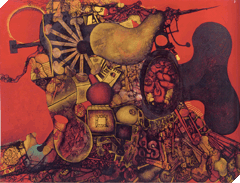 Armed City, 1979 So I do understand what you're trying to say. Without expressing or saying something specific, the act of painting becomes your tool of expression. Without doubt, painting is a free exercise based on ones own rules, but I did not want to follow any movement of abstract painting like what Pollock was doing. I did want to find meaning outside of the painted frame. But meaning is not something as simple as being against the war or if I may exaggerate, about the human condition. All I can say is that war is a fight between men. Women and children do not belong there. |
Nanking Massacre also called Rape Of Nanking (December 1937–January 1938), mass killing and ravaging of Chinese citizens and capitulated soldiers by soldiers of the Japanese Imperial Army after its seizure of Nanking, China, on Dec. 13, 1937, during the Sino-Japanese War that preceded World War II. The number of Chinese killed in the massacre has been subject to much debate, with most estimates ranging from 100,000 to more than 300,000.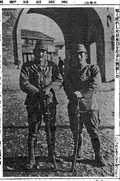 Two Japanese sublieutenants, Mukai Toshiaki and Noda Takeshi said to be competing with each other to see who could kill one hundred Chinese first. The bold headline said, "Contest to Kill First 100 Chinese with Sword Extended When Both Fighters Exceed Mark--Mukai Scores 106 and Noda 105" |
||
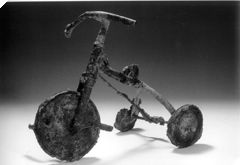 Hiroshima-Tricycle, 1,500m from the hypocenter / Higashi-hakushima-cho (denoted by Tetsutani Nobuo) 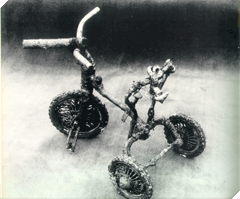 Tricycle, 1980 Object, 55x42x65cm At that period you made a lot of similar sort of objects. Just to clarify, did you know about the picture of the tricycle in Hiroshima? |
Tetsutani Shinichi (then 3 years and 11 months) was exposed while riding his tricycle in front of his house and died the same day. Because Shinichi's father felt that laying a 3-years-old alone in a distant grave was too pitiful, he buried this tricycle in the back yard along with his son. In the summer of 1985, 40 years later, his bones were dug up and placed in a formal grave. The tricycle was denoted to the Hiroshima Piece Memorial Museum. |
||
After leaving Japan in 1989, I haven't been able to see any of his recent work. It is an honor to be able to contribute to the knowledge of his work and life in Europe by publishing this interview and the letters he wrote me. There were some questions I asked him later in a letter which he was able to answer after he left the Hospital. Of course I thought it was dangerous, the war was still going on at that time, but there was no other way; we had to earn money to survive. 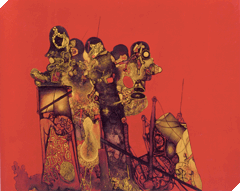 Soldiers, 1979 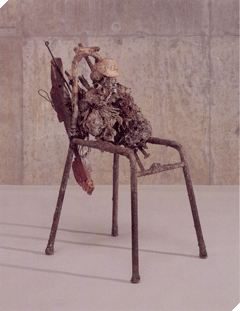 A soldier - object, 1980 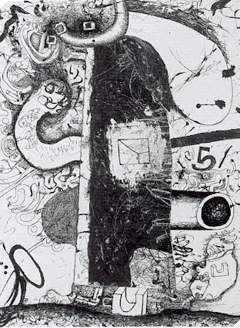 Walking, 1988 pen on paper, 55.2x40.0 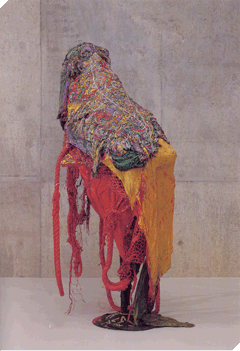 Mr. Homeless, 2001 object, 163.0x68.0x85.0 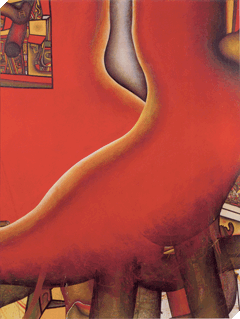 Laughing-an escaped prisoner, 1998 oil on canvas, 259.0x194.0 |
|||
|
|
